Contents
Bordered polypore is a bright saprophyte mushroom with an unusual color in the form of colored rings. Other names used in the scientific literature are pine fungus and, more rarely, tree sponge. In Latin, the mushroom is called Fomitopsis pinicola.
Description of the bordered tinder fungus
The bordered tinder fungus has a sessile fruiting body adhering to the tree bark. The shape of a young mushroom is a semicircle or a circle, old specimens become pillow-shaped. The leg is missing.
The perennial fruit body of the bordered tinder fungus, as shown in the photo, is divided into several colored zones in the form of semicircles.
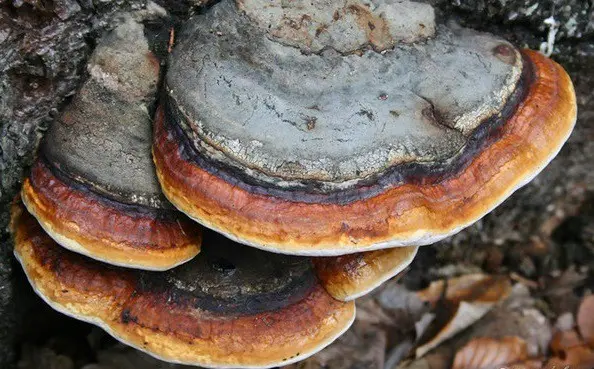
On the border of each circle, small depressions can be distinguished
The old parts of the fruit body are painted in gray, gray or black, the new parts that grow outside are orange, yellow or red.
The pulp of the bordered tinder fungus is rough, hard, spongy, becomes corky, woody with age. At the break, it is light yellow or beige, in overripe specimens it is dark brown.
The reverse side of the fruiting body (hymenophore) is cream, beige, tubular structure. When damaged, the surface darkens.
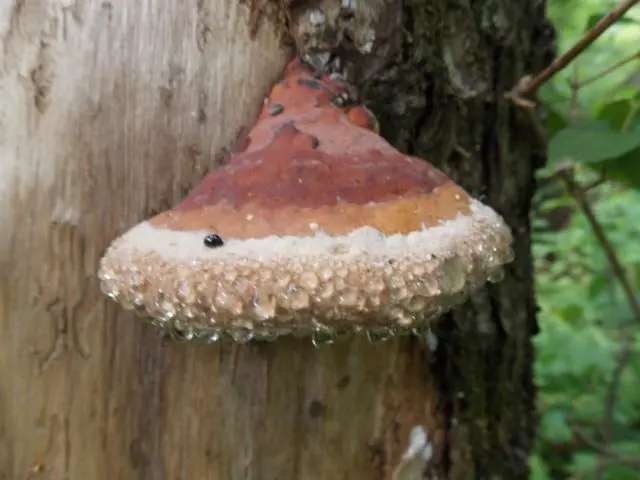
The skin of the mushroom is matte, velvety, with high humidity, liquid droplets appear on it
The size of the cap varies from 10 to 30 cm in width, the height of the fruiting body does not exceed 10 cm.
Spores are spherical, oblong, colorless. The spore powder can be white, yellowish or cream. If the weather is dry and warm, sporulation is abundant, traces of spore powder can be seen below the fruiting body.
Where and how to grow
The bordered polypore (fomitopsis pinicola) grows in a temperate climate; it is distributed everywhere in Our Country. The fungus grows on stumps, fallen trees, and can also be found on dead wood. He chooses both deciduous and coniferous trees, hitting sick and weakened units. Growing on the trunks, bordered tinder fungus provokes the appearance of brown rot.
Is the mushroom edible or not?
It is eaten, but as a mushroom seasoning, since the fruiting body instantly hardens after harvesting. Saprophyte does not cause poisoning.
Twins and their differences
The bordered tinder fungus has a bright, recognizable color, it is difficult to confuse it with other representatives of the species.
Somewhat similar to the mushroom described – the tinder fungus is real. The form and habitats of these representatives of the species are identical.
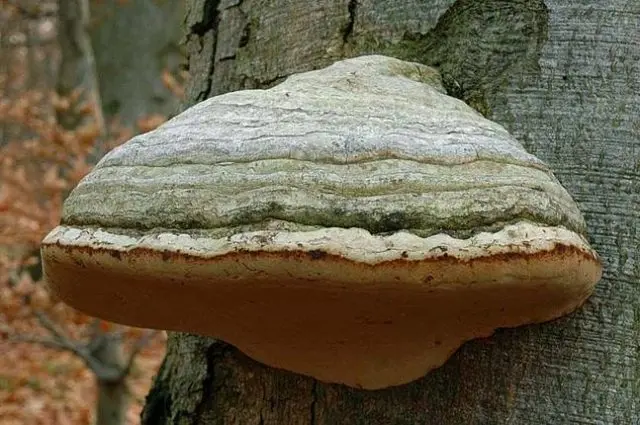
The only difference is the light gray, smoky color of the real tinder fungus, it is classified as an inedible species.
The benefits and harms of bordered tinder fungus in nature
The described fungus can cause irreparable harm. But in folk medicine, it is considered a useful component of many drugs.
Why are pine tinder fungi dangerous for trees
Developing under the bark of a tree, the mycelium of a wood sponge causes the appearance of brown rot. This disease completely destroys deciduous or coniferous crops, turning their trunks into dust.
In the northern regions of Our Country, pine tinder fungus destroys wood in warehouses at logging sites. There is a serious fight with him. Also, the fungus is dangerous for wooden buildings made from treated wood.
In all regions of the country, the bordered tinder fungus causes damage to forestry and park management.
The role of bordered tinder fungi in the ecosystem
An important natural process is the decay and decomposition of wood. The fungus acts as a forest orderly, decomposing diseased, obsolete trees. Also, the bordered tinder fungus is involved in the process of destroying the remnants of flax processing.
Wood sponge destroys organic residues, turning them into mineral fertilizers, improving the quality and fertility of the soil. Cultivated and forest plants receive more nutrients in the process of growth.
Medicinal properties of pine fungus
The mushroom is used in folk medicine. It is believed to have medicinal properties.
Some of them:
- hemostatic effect;
- anti-inflammatory properties;
- normalization of metabolism;
- increased immunity;
- treatment of the organs of the genitourinary system;
- removing toxins from the body.
Thanks to the last of these properties, the tinder fungus is used as part of antivenoms.
Also, the fruiting body of the fungus contains substances – lanophiles. Their use is considered effective for the restoration of the affected liver. They encourage the diseased organ to secrete enzymes that break down fat and other difficult-to-digest substances, which helps to restore normal metabolic processes in the body.
The use of bordered tinder fungi in folk medicine
Wood sponge is harvested starting in August.
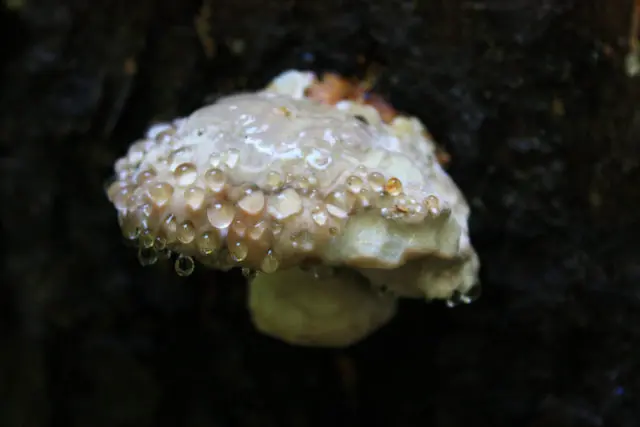
Unripe, young fruiting bodies have the greatest medicinal value.
For the preparation of medicines based on tinder fungus, it is dried and ground into powder.
For the treatment of prostate adenoma, a dangerous male disease that provokes the development of oncology, a decoction is prepared.
In a saucepan, mix half a liter of water and 2 tbsp. l. mushroom powder from tinder fungus. The container is put on fire and brought to a boil. Boil the medicine for an hour over low heat. Then cool and filter.
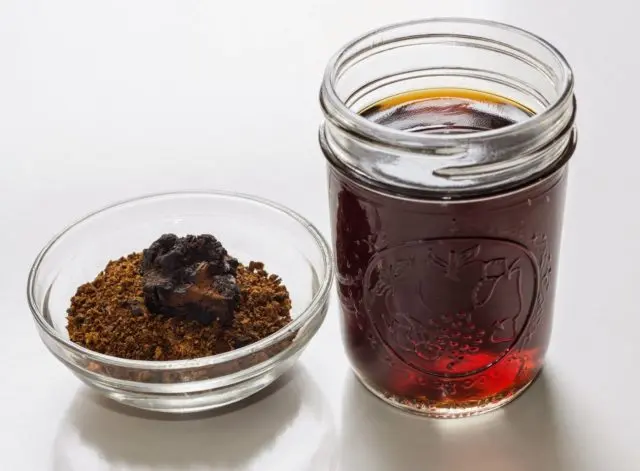
Take a decoction of 200 ml in the morning and evening
Take a decoction of 200 ml in the morning and evening
The healing properties of pine tinder infused with vodka are especially well manifested. The mushroom is prepared shortly after being harvested, as it tends to harden quickly.
Preparation:
- A fresh, freshly picked mushroom is washed, the skin is removed – it is bitter.
- 1 or 2 fruit bodies are crushed with a blender to a puree state.
- The gruel (3 tablespoons) is transferred to a bottle with dark glass and poured with vodka (0,5 l), tightly closed.
- Infuse the remedy for 1,5 months at room temperature in a dark place.
Pre-filtered, ready-made infusion (1 tablespoon) is diluted with 125 ml of boiled water and taken twice a day.
Alcohol tincture will strengthen the immune system, speed up the metabolism, and contribute to weight loss.
For a tonic effect, take an aqueous tincture of the bordered tinder fungus. For cooking, the ingredients are taken in the following ratio: for 0,5 liters of boiling water, 1 tbsp. l. chopped mushrooms.
The pulp of the tinder fungus is cut into large pieces, placed in a thermos, poured with boiling water. The container is closed, the infusion is left overnight. In the morning, the remedy is filtered, take half a glass twice a day. The course of treatment is 15 days. Then make a week break, repeat the treatment. Such therapy will not only increase the body’s resistance to diseases, but also speed up the metabolism, reduce weight, cleanse the intestines.
Limitations and contraindications
The bordered tinder fungus is not a poisonous species, but it is not eaten because of its hardness and bitterness. For treatment with tinctures and other medicines prepared from its pulp, there are a number of restrictions.
Contraindications:
- children up to 7 years;
- blood incoagulability;
- anemia;
- internal bleeding;
- During pregnancy and breastfeeding.
Infusions prepared using bordered tinder fungus are taken carefully. An overdose threatens with the appearance of vomiting, dizziness, and an allergic reaction. In rare cases, the fungus can cause hallucinations.
Why does the bordered tinder fungus cause vomiting when overdosed
The fruiting body of the basidiomycete contains a large amount of resinous substances. In alcoholic infusions and decoctions, their concentration increases. Medicines based on a wood sponge are used with caution, as they can cause vomiting due to the presence of resinous substances in the composition.
Interesting facts about pine tinder fungi
Artists use the fruiting body of an old bordered tinder fungus to make felt-tip pens. They are hard enough to draw on and can be resized to your liking.
Before the invention of electricity, the pulp of a tree sponge was used as flint to start a fire.
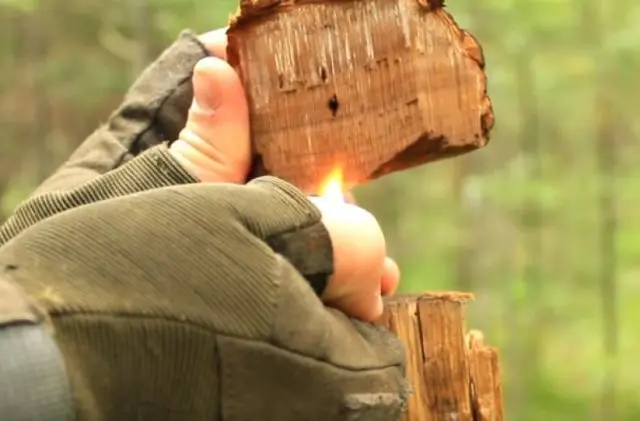
It is used instead of coals for a forest fire.
Long before that, hats were made from the pulp of some bordered tinder fungi. The lower tubular part of the fungus was cut off, soaked in an alkali solution for about a month, then the material was beaten off. The result was something between suede and felt.

Gloves, hats, raincoats were made from such fabric.
Some fruiting bodies reached such huge sizes that in the 19th century a cassock was sewn from one such specimen for a German bishop, and this is a historical fact.
Today, craftsmen make souvenirs and crafts from the fruiting body of this basidiomycete.
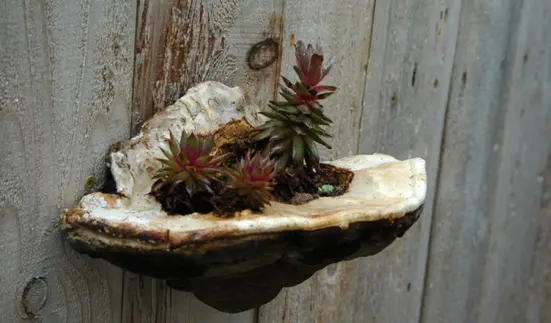
By covering the tinder fungus with varnish and making a recess in it, you can get a flower pot for succulents
Beekeepers use wood sponge as a smoker filler.
For the preparation of medicines, a fruiting body growing on living trees is cut.
If you set fire to the pulp of a pine sponge and leave it smoldering near a hornet’s nest, you can permanently get rid of harmful insects.
Dried and crushed tinder fungus (100 g), diluted in 1 liter of water, is used against late blight. The aqueous solution is boiled, then cooled and the affected plants are sprayed with it.
If the pulp of the basidiomycete is soaked with saltpeter, cut into several pieces and dried, you can get a material for lighting fires.
Lotions from a decoction of a polypore fungus help to cure papillomas and other unaesthetic formations on the skin.
It is impossible to get rid of a tree sponge in the garden with folk or industrial means. Such measures to combat the bordered tinder fungus are ineffective. If the tree is still alive, the mycelium is cut out along with the bark and part of the trunk, the wound is sealed with garden pitch, and the woody remains are burned along with the saprophyte.
Conclusion
Bordered polypore is a saprophyte fungus that parasitizes deciduous and coniferous trees. Its appearance signals the weakness of the plant culture. Soon after the first fruiting bodies ripen, the bark becomes covered with brown rot, which completely destroys the trunk. The wood sponge, as the fungus is also called, carries not only diseases and decomposition for plants, the basidiomycete is used in folk medicine as a panacea for many ailments.









